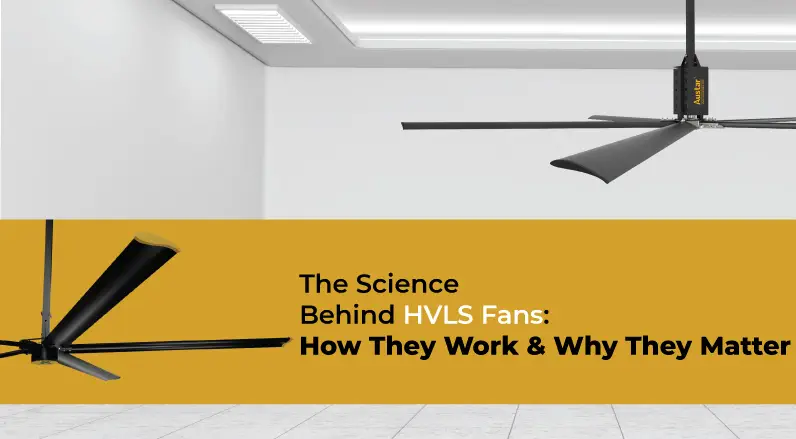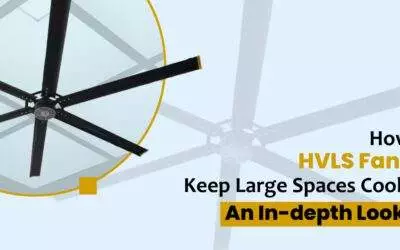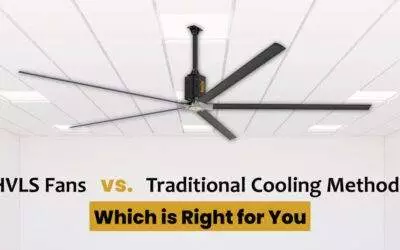The Science Behind HVLS Fans: How They Work and Why They Matter

What Are HVLS Fans?
HVLS fans are characterized by their large diameter—typically ranging from 7 to 24 feet—and their ability to move air efficiently across vast spaces. Unlike traditional high-speed fans that focus on a small area, HVLS fans distribute air evenly over a large area, making them ideal for spaces with high ceilings and large footprints.
Key Components of HVLS Fans
- Blades: HVLS fans typically have fewer, larger blades compared to conventional fans. The blades are designed with an aerodynamic shape that enhances airflow while minimizing noise.
- Motor: The motor used in HVLS fans is engineered for efficiency and durability. Many models utilize direct-drive motors that require less maintenance than traditional belt-driven systems.
- Control Systems: Modern HVLS fans often come equipped with advanced control systems that allow for variable speed settings and integration with building management systems.
- Mounting Hardware: The mounting hardware is designed to ensure stability and safety, accommodating the fan’s large size and weight.
How HVLS Fans Work
The operation of HVLS fans is rooted in fundamental principles of fluid dynamics and thermodynamics. Understanding how HVLS fans work requires a look at their airflow patterns and the physics behind their design.
1. Airflow Dynamics
HVLS fans create a gentle, downward airflow that can cover a large area. The fans’ large blades move air at a low speed, which reduces the turbulence often associated with high-speed fans. This low-speed airflow creates a more comfortable environment by promoting even temperature distribution and reducing localized hot spots.
2. The Coanda Effect
One of the critical principles behind the effectiveness of HVLS fans is the Coanda effect. This phenomenon occurs when a fluid (in this case, air) flows over a curved surface and adheres to it. The design of HVLS fan blades encourages this effect, allowing the fan to move air along the ceiling and down the walls, which helps to circulate air throughout the entire space.
3. Evaporative Cooling
When HVLS fans operate, they enhance the evaporation of moisture from the skin, which leads to a cooling sensation. This is particularly beneficial in warm environments, where the fans can create a more comfortable atmosphere without the need for excessive air conditioning. The gentle breeze generated by the fans can make a significant difference in perceived temperature, allowing for higher thermostat settings and reduced energy consumption.
4. Energy Efficiency
HVLS fans are designed to operate at low speeds, which means they consume significantly less energy than traditional high-speed fans or air conditioning systems. The energy-efficient motors used in HVLS fans can save businesses a considerable amount on their energy bills while still providing effective air circulation.
Why HVLS Fans Matter
The importance of HVLS fans extends beyond mere comfort. They play a crucial role in various applications, offering numerous benefits that make them an essential investment for many facilities.
1. Improved Comfort
HVLS fans create a uniform temperature throughout a space, which is essential for employee comfort and productivity. In industrial settings, where workers may be exposed to heat and humidity, HVLS fans can significantly improve working conditions by providing a cooling effect without creating drafts.
2. Enhanced Air Quality
By promoting air circulation, HVLS fans help to improve indoor air quality. Stagnant air can lead to the accumulation of pollutants, odors, and humidity. The gentle airflow created by HVLS fans helps to mitigate these issues by promoting the mixing of air and aiding in the removal of contaminants.
3. Cost Savings
The energy efficiency of HVLS fans translates to significant cost savings for businesses. By reducing reliance on air conditioning systems, facilities can lower their energy consumption and associated costs. Additionally, the durability of HVLS fans means lower maintenance and replacement costs over time.
4. Versatility
HVLS fans are versatile and can be used in a variety of settings, including:
- Warehouses: To maintain a consistent temperature and improve worker comfort.
- Manufacturing Facilities: To enhance air circulation and reduce heat buildup from machinery.
- Gymnasiums and Sports Facilities: To create a comfortable environment for athletes and spectators.
- Retail Spaces: To improve customer comfort and enhance the shopping experience.
5. Environmental Impact
By reducing energy consumption, HVLS fans contribute to a lower carbon footprint. Businesses that prioritize sustainability can benefit from the installation of HVLS fans as part of their overall energy management strategy.
Selecting the Right HVLS Fan
When considering the installation of HVLS fans, several factors must be taken into account to ensure optimal performance and effectiveness.
1. Size of the Space
The size and layout of the space will dictate the number and size of HVLS fans required. Larger spaces may need multiple fans to achieve adequate airflow, while smaller areas may only require one or two.
2. Ceiling Height
The height of the ceiling will also influence the choice of HVLS fans. Fans need to be mounted at a height that allows for effective airflow while ensuring safety and compliance with building codes.
3. Airflow Requirements
Understanding the specific airflow needs of the space is crucial. Different applications may require varying levels of air circulation, and selecting the right fan speed and size will help meet those requirements.
4. Control Options
Modern HVLS fans come with various control options, including remote controls, wall-mounted switches, and integration with building management systems. Choosing the right control system can enhance the efficiency and usability of the fans.
Conclusion
HVLS fans represent a significant advancement in the field of air movement technology. Their ability to circulate large volumes of air at low speeds not only enhances comfort and air quality but also offers substantial energy savings and versatility across various applications. Understanding how HVLS fans work and the benefits they provide is essential for businesses aiming to create optimal indoor environments while minimizing their environmental impact. As industries continue to seek innovative solutions for air circulation and climate control, HVLS fans stand out as a vital component in achieving these goals.
How HVLS Fans Keep Large Spaces Cool: An In-depth Look
How HVLS Fans Keep Large Spaces Cool: An In-depth LookTable of Contents - Introduction- Why Large Spaces Need Effective Cooling Solutions-...
HVLS Fans vs. Traditional Cooling Methods: Which is Right for You
HVLS Fans vs. Traditional Cooling Methods: Which is Right for YouTable of Contents 1. Introduction 2. Understanding the Basics 3. Exploring...


